North America Secondary Packaging Market Size
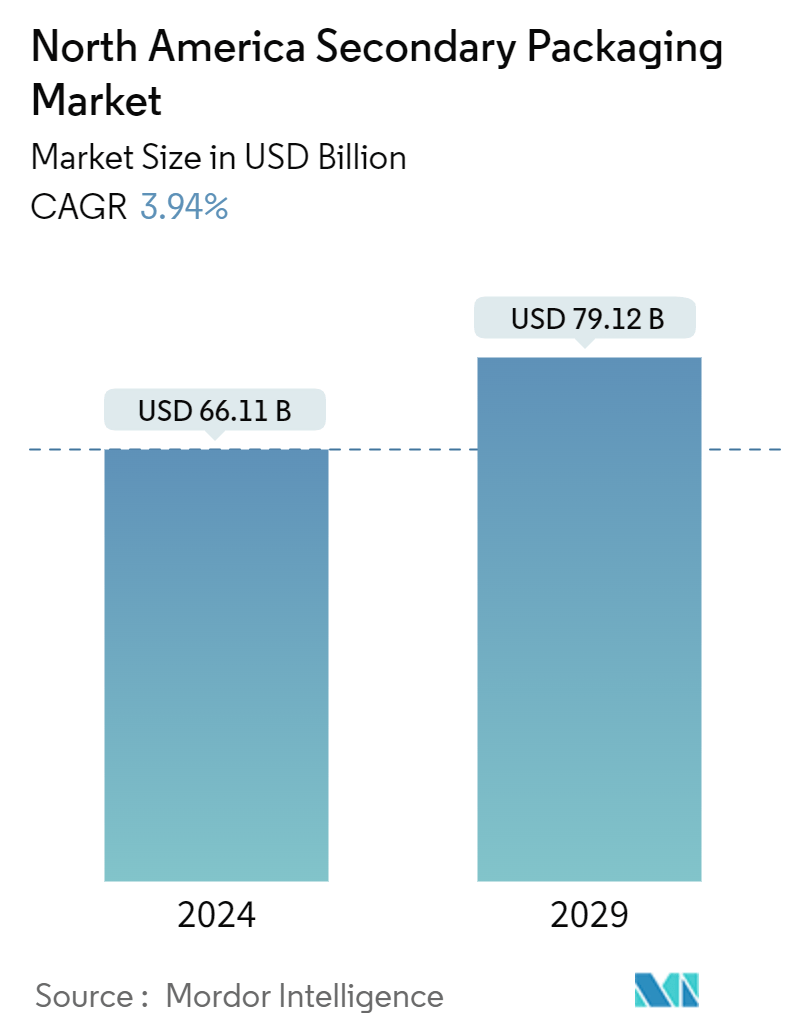
| Study Period | 2019 - 2029 |
| Base Year For Estimation | 2023 |
| Market Size (2024) | USD 66.11 Billion |
| Market Size (2029) | USD 79.12 Billion |
| CAGR (2024 - 2029) | 3.94 % |
| Market Concentration | Low |
Major Players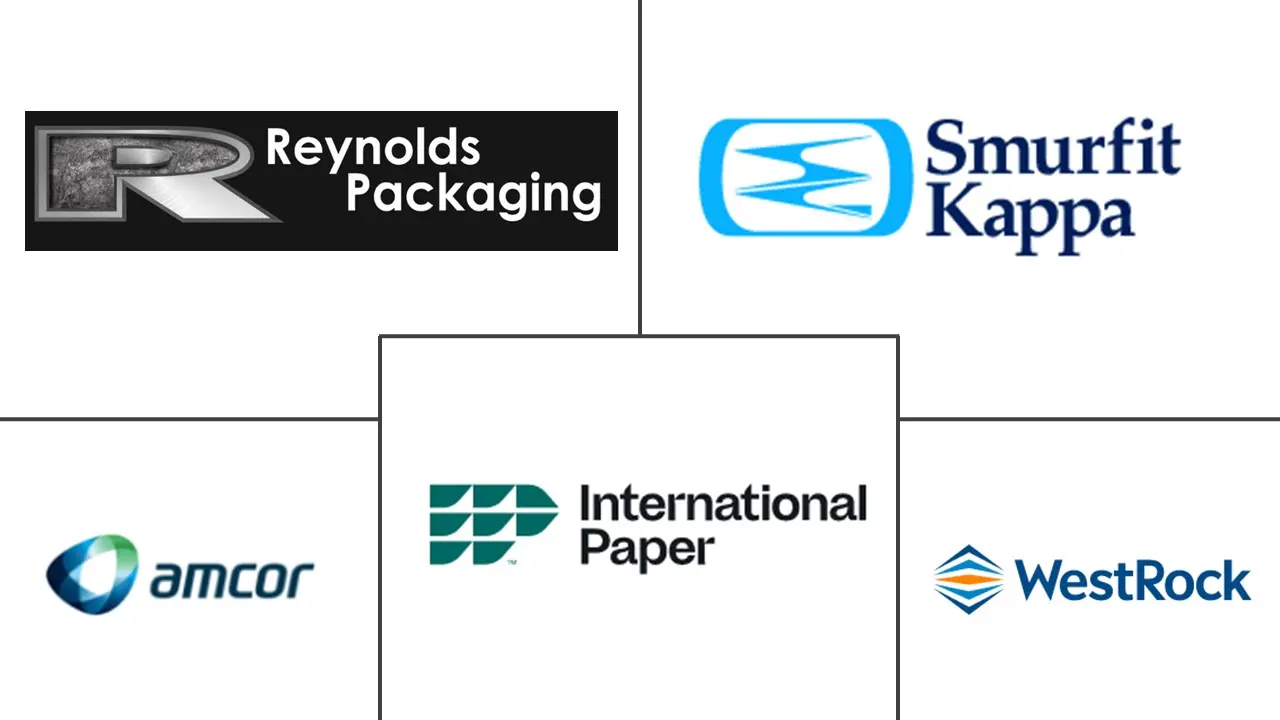
*Disclaimer: Major Players sorted in no particular order |
North America Secondary Packaging Market Analysis
The North America Secondary Packaging Market size is estimated at USD 66.11 billion in 2024, and is expected to reach USD 79.12 billion by 2029, growing at a CAGR of 3.94% during the forecast period (2024-2029).
The North American secondary market was estimated at USD 60.40 billion in the previous year. The market is expected to reach USD 76.76 billion over the forecast period, witnessing a CAGR of 3.94%. The United States and Canada are massive consumer markets, and the population's considerable buying power makes it a lucrative market for all package suppliers. As a result, the North American secondary packaging market is anticipated to grow over the upcoming year due to the growing demand for food packaging, a string of successful e-commerce transactions, and the demand for safety in packaging transportation.
- The rising use of environment-friendly materials in packaging is driving the secondary packaging market in North America. Packaging that is recyclable, biodegradable, reusable, non-toxic, and has a minimal environmental impact is considered eco-friendly. The need for environment-friendly packaging materials is becoming increasingly apparent to end users, including the food and beverage industry and manufacturers of household care products. Packaging formats like folding cartons and corrugated boxes have no adverse effects on the environment because they are constructed of recyclable and biodegradable materials, such as paperboard.
- The demand for convenience foods is on the rise due to the busy lifestyle of people. As corrugated board packaging keeps moisture from the products and withstands long shipping times, companies are increasingly adopting it to offer customers better outcomes, especially secondary or tertiary packaging. Processed foods, such as bread, meat products, and other perishable items, need these packaging materials to be used once, thereby driving the demand.
- Since the corrugated board is easy to recycle and the pulp and paper industry is already skilled at converting it into new generations of containerboard, it is becoming increasingly common in packaging as sustainability concerns become more relevant across the value chain. Due to these benefits, corrugated protective forms have gained popularity over polymer-based substitutes, such as expanded polystyrene (EPS) foams.
- Additionally, increasing courier and messengers' revenue indicates the use of secondary packagings, such as corrugated boards and folding cartons packaging, in transiting the products from one place to another. According to the US Department of Commerce, in 2021, the US couriers and messengers generated almost USD 137.91 billion in operating revenue. UPS is the largest courier and delivery service provider in the United States, with around 40% of the courier market.
- Secondary packaging still raises environmental questions, but there are also other challenges to solve. In online purchasing, all have encountered the bother and disappointment of receiving a flawed, incomplete, or inaccurate product due to subpar or insufficient secondary packaging. However, since secondary packaging comes after primary packaging, any issues resulting from a stoppage impact the rest of the production line. Production and delivery plans are disrupted by downtime, which also increases product waste and brings labor expenses back into the expense column. Production planning should ideally include anticipating and reducing stoppages through advanced planning.
North America Secondary Packaging Market Trends
Consumer Electronics to Witness Significant Growth
- Consumer electronics firms are being pushed by government and legislation in addition to consumer-driven sustainable packaging. This is notably true in the United States, where legislation for expanded producer responsibility programs, single-use packaging limitations, and other issues is being examined.
- Secondary packaging, such as folding cartons and corrugate boxes, is used for heavy and small electrical component packaging. Corrugated boxes pack consumer products, such as home appliances, refrigerators, HVAC units, etc. Apart from these, smaller electrical components and accessories, such as circuit breakers, tapes, light bulbs, etc., also use paper-based materials for secondary packaging.
- According to Consumer Technology Association, the retail sales of consumer electronics (CE) in the US market increased steadily from 2015 to 2022. According to forecasts, retail sales of consumer electronics are expected to grow by USD 485 billion in the United States in 2023. Revenue from OLED Televisions is expected to reach USD 2.3 billion in 2023.
- A strong need for anti-counterfeiting in electronics packaging drives the North American market. The packaging uses overt and covert technology, such as barcodes, holograms, sealing tapes, and radiofrequency identifying devices, to protect the integrity of items. The rapid growth of e-commerce in emerging economies has benefited the worldwide anti-counterfeit electronics packaging industry.
- Furthermore, environmental-friendly packaging is becoming popular for electrical devices. Government authorities and regulators have made a strong push for the adoption of green packaging. Both brands and customers are becoming more aware of environmentally friendly packaging and the importance of safeguarding the environment from non-biodegradable packaging trash.
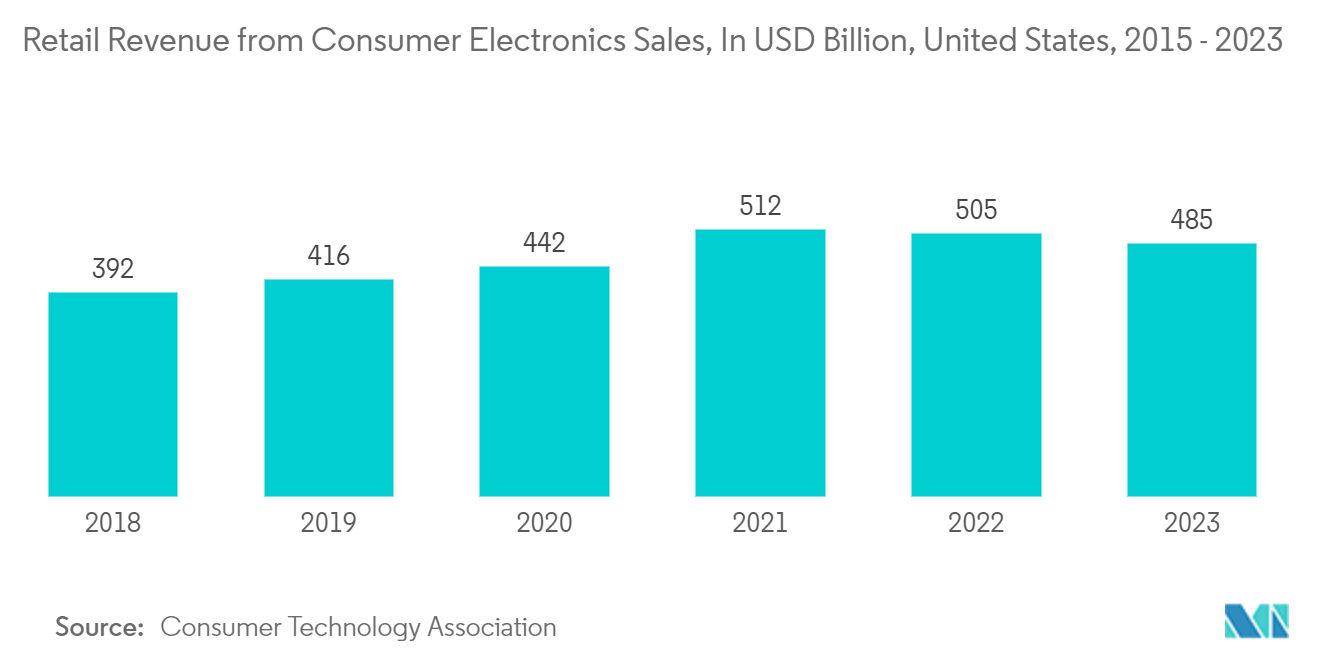
Canada Expected to Witness Significant Growth
- The Canadian secondary packaging market was valued at USD 6.79 billion the year before. Corrugated board packaging is an economical way to safeguard and transport various goods. The corrugated board's qualities, such as light weightiness, biodegradability, and recyclability, have made it a vital component in the packaging business. Sealed Air will focus on creating 100% recyclable or reused packaging by 2025. Around 50% of its solutions have already been made with recycled material.
- To improve their presence and position in the market, vendors in Canada have focused on growth, partnership, and collaboration initiatives. Similarly, in December 2022, Titan Corrugated and its associate All Boxed Up were acquired by UFP Packaging, a branch of UFP Industries, a US-based holding firm. The acquired company manufacture standard-sized distributed across the United States via All Boxed Up.
- The country's developing e-commerce market generates demand for corrugated and paper goods, notably from players in the transportation and logistics sectors. Paper-based packaging, which is adaptable and affordable, has been used to carry, protect, and preserve many items.
- According to Worldpay, mobile e-commerce earned over USD 28 billion in Canada in 2021, compared to USD 53 billion from desktop e-commerce. Additionally, it predicts that these amounts will rise to USD 57 billion and USD 81 billion in mobile and desktop sales by 2025. This growth is anticipated to show a proportionate rise in the nation's demand for corrugated packing boxes within the specified time frame.
- Canada's e-commerce infrastructure is highly developed and closely integrated with the United States. The major online retailers in Canada include Amazon, Wal-Mart, Canadian Tire, Costco, Best Buy, Hudson's Bay, and Etsy.
- Canadian consumers rely upon the internet to place orders. Internet consumer sales have risen more in the past decade than traditional retail sales. Most Canadian retail firms have adopted wireless technologies and internet-based systems to improve business-to-business and business-to-consumer relations.
- As Canada is one of the heaviest internet users, consumers have embraced electronic commerce amid a significant disruption in retail channels. According to Edge by Ascential, retail chain e-commerce gross sales in Canada accounted for USD 47.3 billion in 2022. Retail e-commerce sales are estimated to total USD 73.9 billion by 2027.
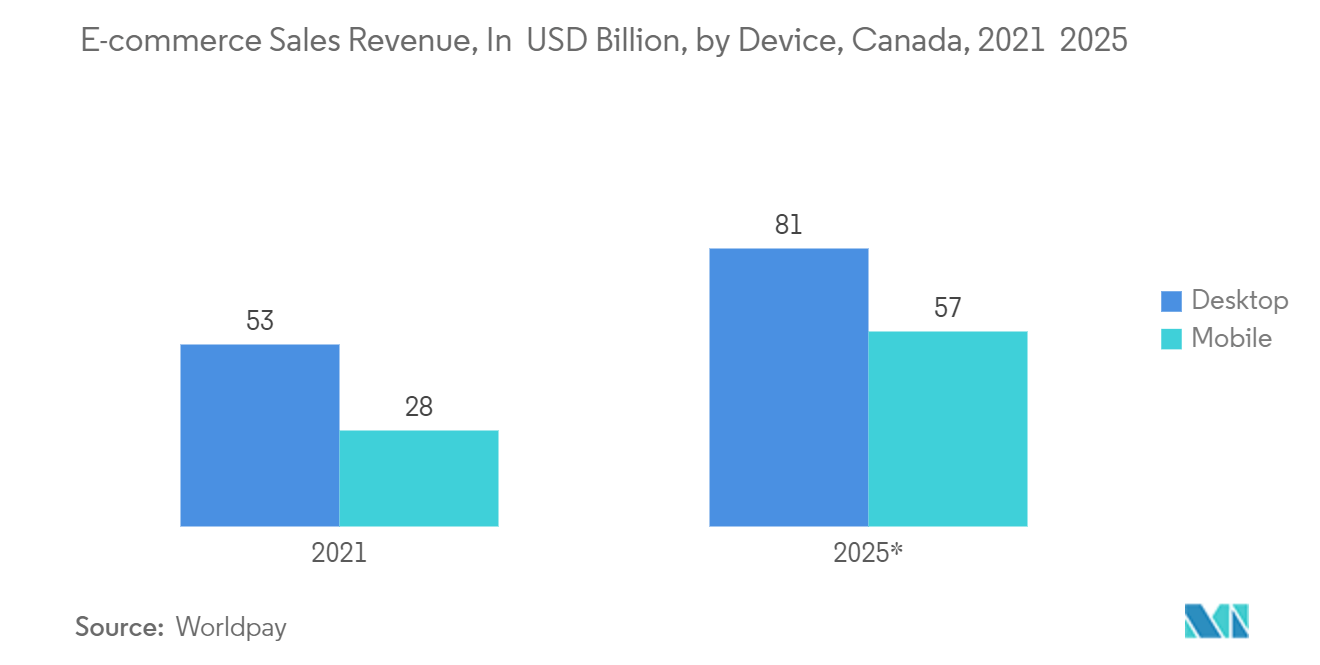
North America Secondary Packaging Industry Overview
The North American secondary packaging market is fragmented, with the presence of major players like Amcor PLC, International Paper Company, Reynolds Packaging, Westrock Company, and Smurfit Kappa Group. The market incumbents are adopting powerful competitive strategies characterized by acquisitions, partnerships activities, a strong emphasis on R&D, and innovative activities.
- March 2023: Amcor and Nfinite Nanotechnology Inc. launched a collaborative research initiative to test the application of Nfinite's nanocoating technology to improve recyclable and biodegradable packaging.
- June 2022: Mondi sold Nitto Denko Corporation its Personal Care Components business (PCC) for an enterprise value of EUR 615 million (USD 681.17 million). The sale allowed Mondi to streamline its holdings and concentrate on its strategic goal of expanding in sustainable packaging.
North America Secondary Packaging Market Leaders
-
Amcor PLC
-
International Paper Company
-
Reynolds Packaging
-
Westrock Company
-
Smurfit Kappa Group
*Disclaimer: Major Players sorted in no particular order
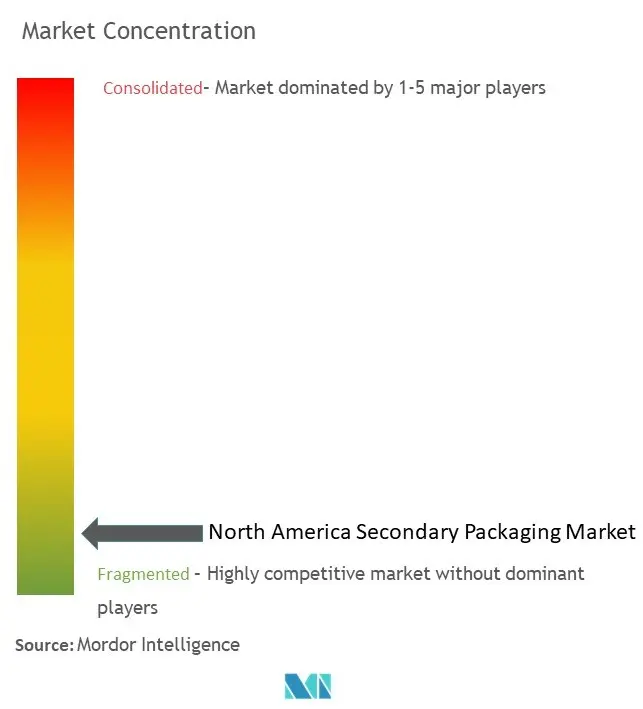
North America Secondary Packaging Market News
- February 2023: Ara Partners announced the acquisition of Genera Energy Inc., a non-wood agricultural pulp and molded fiber products company. The firm also committed additional funding to support the significant expansion of its sustainable pulp and packaging business.
- February 2023: Mill Rock Packaging Partners LLC acquired Keystone Paper & Box Company. This leading specialty packaging company manufactures custom folding cartons for consumer and healthcare end markets.
- January 2023: Cascades, a packaging firm based in North America, disclosed releasing a new closed basket for the produce industry made of recyclable and recycled corrugated cardboard. This new product is the most recent addition to Cascades' collection of environment-friendly packaging and serves as an alternative to food packaging that is challenging to recycle. This product was created utilizing acknowledged eco-design principles. It adheres to a circular economy philosophy. Cascades are helping its clients lessen their environmental impact by incorporating recycled corrugated cardboard in its design and satiating consumer desire for more environment-friendly packaging.
North America Secondary Packaging Market Report - Table of Contents
1. INTRODUCTION
- 1.1 Study Assumptions and Market Defnition
- 1.2 Scope of the Study
2. RESEARCH METHODOLOGY
3. EXECUTIVE SUMMARY
4. MARKET INSIGHTS
- 4.1 Market Overview
- 4.2 Industry Value Chain Analysis
-
4.3 Industry Attractiveness - Porter's Five Forces Analysis
- 4.3.1 Bargaining Power of Suppliers
- 4.3.2 Bargaining Power of Buyers
- 4.3.3 Threat of New Entrants
- 4.3.4 Threat of Substitutes
- 4.3.5 Intensity of Competitive Rivalry
- 4.4 Assessment of the Impact of COVID-19 on the Industry
5. MARKET DYNAMICS
-
5.1 Market Drivers
- 5.1.1 Increased Demand in FMCG Industries
- 5.1.2 Increased Demand for Security and Tracking Solutions
-
5.2 Market Challenges
- 5.2.1 Lack of Ubiquitous Standards, Safety Concerns, and Inability to Withstand Harsh Climatic Conditions
6. MARKET SEGMENTATION
-
6.1 By Product Type
- 6.1.1 Corrugated Boxes
- 6.1.2 Folding Cartons
- 6.1.3 Plastic Crates
- 6.1.4 Wraps and Films
- 6.1.5 Other Product Types
-
6.2 By End-user Industry
- 6.2.1 Food
- 6.2.2 Beverage
- 6.2.3 Healthcare
- 6.2.4 Consumer Electronics
- 6.2.5 Personal Care and Household Care
- 6.2.6 Other End-user Industries
-
6.3 By Country
- 6.3.1 United States
- 6.3.2 Canada
7. COMPETITIVE LANDSCAPE
-
7.1 Company Profiles*
- 7.1.1 Amcor PLC
- 7.1.2 International Paper Company
- 7.1.3 Reynolds Packaging
- 7.1.4 WestRock Company
- 7.1.5 Smurfit Kappa Group
- 7.1.6 Berry Global Group Inc.
- 7.1.7 Packaging Corporation of America
- 7.1.8 Deufol SE
- 7.1.9 Mondi PLC
- 7.1.10 Tranpak Inc.
8. INVESTMENT ANALYSIS
9. FUTURE OF THE MARKET
** Subject To AvailablityNorth America Secondary Packaging Industry Segmentation
Secondary packaging includes outer material that protects food, drinks, and consumer goods throughout transit. Secondary packaging is the exterior packaging of the primary packaging that groups a package and further protects a product.
The North American secondary packaging market is segmented by product type (corrugated boxes, folding cartons, plastic crates, wraps and films, and other product types), by end-user industry (food, beverage, healthcare, consumer electronics, personal care, household care and end-user industries), by country (United States and Canada). The report offers market forecasts and size in value (USD) for all the above segments.
| By Product Type | Corrugated Boxes |
| Folding Cartons | |
| Plastic Crates | |
| Wraps and Films | |
| Other Product Types | |
| By End-user Industry | Food |
| Beverage | |
| Healthcare | |
| Consumer Electronics | |
| Personal Care and Household Care | |
| Other End-user Industries | |
| By Country | United States |
| Canada |
North America Secondary Packaging Market Research Faqs
How big is the North America Secondary Packaging Market?
The North America Secondary Packaging Market size is expected to reach USD 66.11 billion in 2024 and grow at a CAGR of 3.94% to reach USD 79.12 billion by 2029.
What is the current North America Secondary Packaging Market size?
In 2024, the North America Secondary Packaging Market size is expected to reach USD 66.11 billion.
Who are the key players in North America Secondary Packaging Market?
Amcor PLC, International Paper Company, Reynolds Packaging, Westrock Company and Smurfit Kappa Group are the major companies operating in the North America Secondary Packaging Market.
What years does this North America Secondary Packaging Market cover, and what was the market size in 2023?
In 2023, the North America Secondary Packaging Market size was estimated at USD 63.51 billion. The report covers the North America Secondary Packaging Market historical market size for years: 2019, 2020, 2021, 2022 and 2023. The report also forecasts the North America Secondary Packaging Market size for years: 2024, 2025, 2026, 2027, 2028 and 2029.
North America Secondary Packaging Industry Report
Statistics for the 2024 North America Secondary Packaging market share, size and revenue growth rate, created by Mordor Intelligence™ Industry Reports. North America Secondary Packaging analysis includes a market forecast outlook to for 2024 to 2029 and historical overview. Get a sample of this industry analysis as a free report PDF download.



